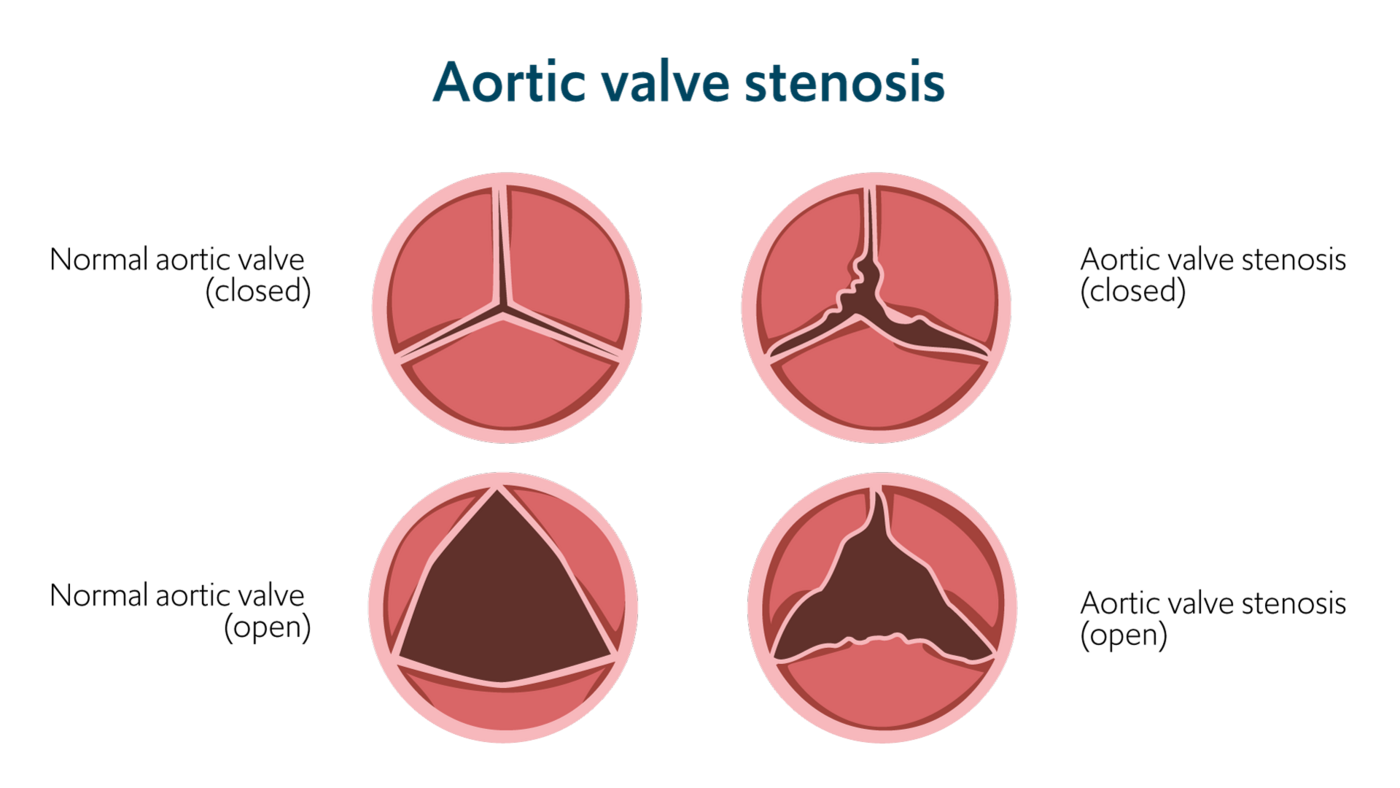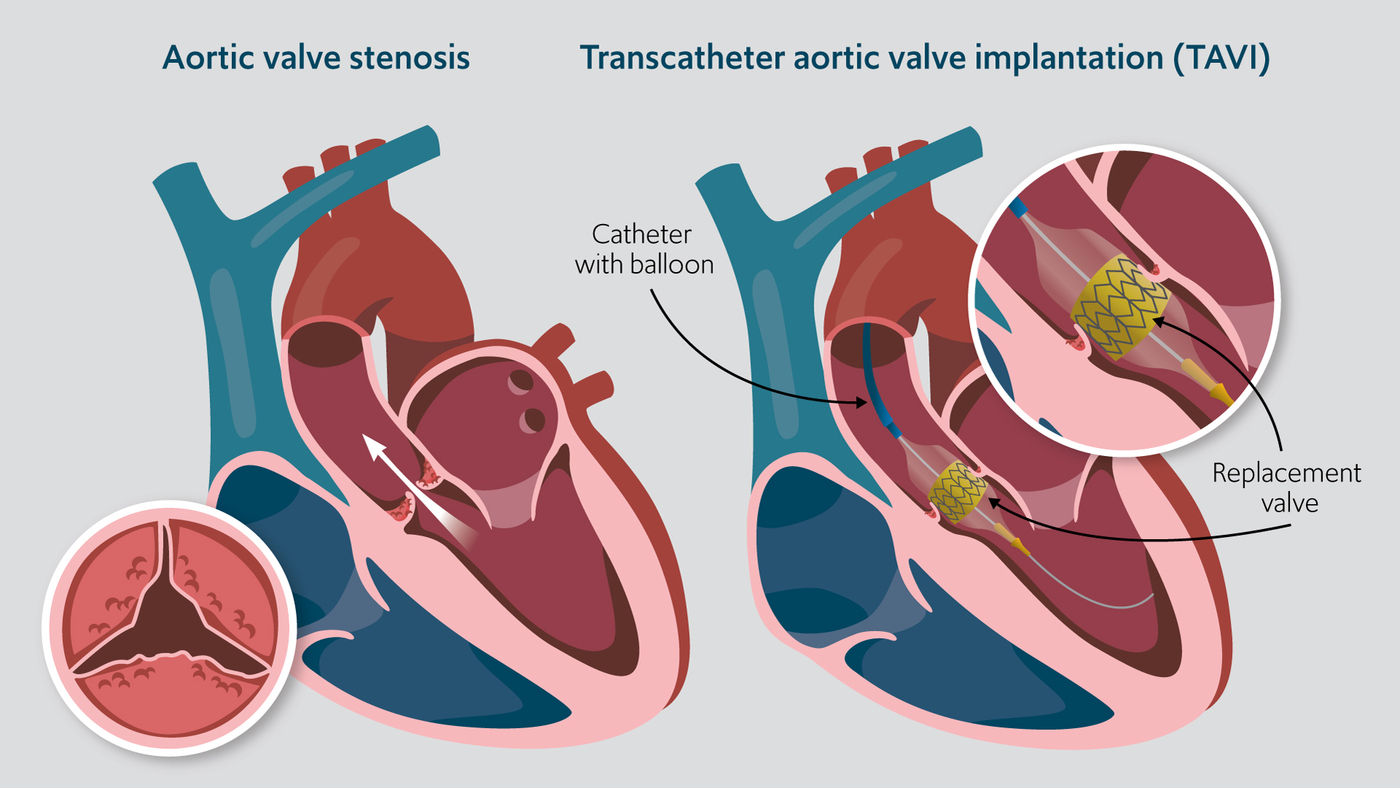What is TAVI?
TAVI stands for transcatheter aortic valve implantation. TAVI is a minimally-invasive procedure in which a new valve is inserted into your heart to treat aortic stenosis (see below).
TAVI is also known as TAVR, especially in the USA; TAVR stands for transcatheter aortic valve replacement.
What is aortic stenosis?
“Aortic stenosis is a common heart condition in which one of the heart’s valves, the aortic valve, becomes thick and stiff because of calcium deposits. The aortic valve becomes progressively narrowed, restricting blood flow,” explains consultant cardiologist Dr Vasileios Panoulas.
It’s more difficult for the heart to pump blood through the narrow valve, which can cause chest pain and breathlessness. You may also notice that you feel tired, dizzy and weak, especially during exertion.
Without treatment, aortic stenosis gradually gets worse. Symptoms typically increase with worsening chest pain and episodes of fainting. The heart needs to work harder to pump effectively, which strains the muscle and, over time, can lead to heart failure.
The best treatment is to replace the aortic valve either through heart surgery or using the minimally-invasive TAVI technique.

Aortic valve stenosis causes the valve to become narrowed, reducing blood flow through the heart.
What does TAVI treat?
TAVI treats a faulty aortic valve in adults with aortic stenosis.
“TAVI can benefit people with symptomatic aortic stenosis, reducing symptoms and improving life expectancy and quality of life. However, as a less invasive treatment, it can be a good treatment option for adults who are too frail and unwell for traditional valve replacement surgery, and those who have a high or even intermediate risk for conventional surgery,” explains Dr Panoulas.
What happens in TAVI?
TAVI is a minimally invasive procedure. The cardiologist inserts a new aortic valve without removing the old, faulty valve. The new valve is placed inside the damaged valve; it compresses the old valve and takes over its function.
Under local anaesthetic, the cardiologist will insert a fine tube, called a catheter, into an artery in your groin or below your collarbone. They will use X-ray video guidance to introduce the catheter into your heart. They will position the catheter in the aortic valve’s opening. If the valve is narrow, they will gently inflate a balloon to compress the diseased valve and make room.
They will insert a new valve made from a mesh metal stent and tissue from pigs or cows. When the valve is in position, it will either expand spontaneously, or your doctor will expand it using a balloon. The new valve will sit inside your old aortic valve.

The replacement valve is inserted inside the damaged valve using a catheter.
Is TAVI painful?
The TAVI procedure should not be painful. If you experience pain or feel unwell, let the team know, and they will take action. The local anaesthetic should prevent any pain when the catheter is inserted and our experienced anaesthetist and nurse seditionist will keep you comfortable.
“After the procedure, you may notice some pain and discomfort at the insertion site, but this should get better over the first few days. The team will prescribe painkillers or recommend over-the-counter analgesia to keep you comfortable,” explains Dr Panoulas.
The benefits of TAVI
The main benefits of the TAVI technique are:
- TAVI reduces symptoms and improves the quality of life in patients with aortic stenosis. In research, people who had TAVI were more likely to survive and avoid hospital admissions than those who did not have the procedure
- performed in the vast majority of cases under local anaesthetic with sedation, not a general anaesthetic
- less invasive procedure
- the heart doesn’t need to be stopped, so you do not require a bypass machine
- you do not need a large incision in your chest and a cut through the sternum
- less time in hospital following surgery
- less pain and a quicker recovery
These factors can make TAVI more suitable for people who are too frail or unwell for valve replacement surgery. Research indicates that it is just as effective as conventional surgery for people in whom open valve replacement is considered of high or intermediate risk. The British Heart Valve Society summarised the National Institute for Health and Care Excellence’s guidelines covering minimally invasive cardiac surgery:
‘The NICE guidance states that transcatheter aortic valve implantation (TAVI) is an option for all patients with an unacceptably high risk of mortality or morbidity from surgery, patients who may have an unacceptably prolonged or strenuous recovery from surgery and also patients with low life expectancy, either due to age or major comorbidities.’ European and American guidelines expand the use of TAVI to patients with intermediate and even low surgical risk, particularly in patients above the age of 75.
Risks of TAVI?
There are risks involved with any medical procedure. Your cardiology team will work to reduce complications and support your recovery.
The risk of complications with TAVI depends on your general health and the health of your heart. People who have multiple illnesses or a history of heart attacks may be more vulnerable to problems. Talk to your hospital team about the risks and benefits in your case.
Potential complications include:
- heart rhythm abnormalities
- bleeding, bruising or infection at the access site
- damage to the access site vessels requiring stent or vascular surgery
- slow heart rate that needs a permanent pacemaker can affect between 1 in 20 and 1 in 10 people
- heart attack
- allergy to the dye during angiography
- if there are complications during surgery, there is a risk that you may need open-heart surgery
- 2-3% of people undergoing the procedure are at risk of stroke
- rarely problems following TAVI may lead to death
Alternatives to TAVI for aortic stenosis
TAVI is not the only treatment for aortic stenosis. Your doctor will be able to discuss the treatment options and help you balance out the pros and cons. The alternatives to TAVI for aortic stenosis include:
Surgical aortic valve replacement: Open heart surgery in which the surgeon removes the damaged aortic and replaces it with a prosthetic valve. Heart surgery is more invasive than TAVI and requires a general anaesthetic; it may be riskier if you have other medical conditions.
Sutureless aortic valve replacement: We offer sutureless aortic valve replacement, an innovative surgical approach for people with aortic stenosis. The procedure allows faster implantation and shorter cardiopulmonary bypass time. Sutureless AVR makes it easier to perform less invasive surgery through a partial sternotomy. Following surgery, patients typically experience less pain and return to activity quicker.
Minimally invasive surgical aortic valve replacement: We offer a smaller incision at the top of the collarbone through which the aortic valve is replaced. This procedure allows for shorter recovery times
Balloon aortic valvuloplasty (BAV): BAV is a minimally invasive procedure that stretches the aortic valve. Treatment temporarily treats the symptoms of aortic stenosis but doesn’t repair or replace the diseased valve. Balloon aortic valvuloplasty may relieve your symptoms for up to six months.
Get in touch
To learn more about TAVI and other treatments offered by our cardiologists, contact our customer services team.
Related content
-
Aortic stenosis
Aortic stenosis is a disease that affects the main outlet valve of the heart and is the third most common cardiovascular disease.
-
Cardiology
Our specialists are continuously innovating in minimally invasive cardiology procedures and improving care delivery.
-
Transcatheter aortic valve implantation (TAVI)
TAVI is a minimally invasive procedure where a new aortic valve is inserted into your heart.
